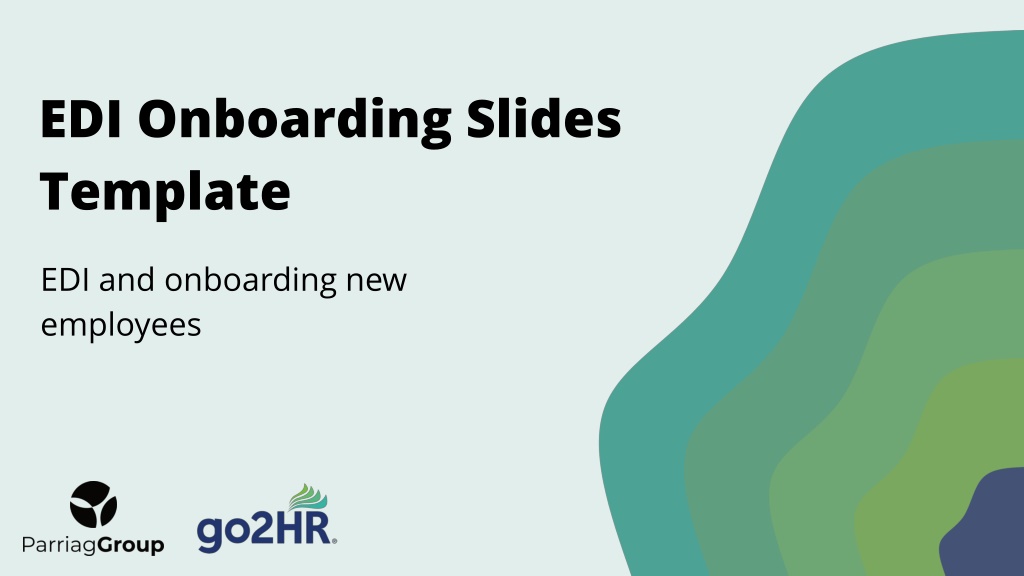Comprehensive Guide to Equity, Diversity, and Inclusion (EDI) Implementation
Explore the essential aspects of Equity, Diversity, and Inclusion (EDI) through customizable slides for onboarding new employees. Understand the significance of fostering a culture where everyone feels valued, and learn how to embody EDI principles in your workplace. Discover what EDI means to your business and how to model EDI through tangible actions. Embrace progress, not perfection, on your EDI journey towards a more inclusive environment.
Download Presentation

Please find below an Image/Link to download the presentation.
The content on the website is provided AS IS for your information and personal use only. It may not be sold, licensed, or shared on other websites without obtaining consent from the author. Download presentation by click this link. If you encounter any issues during the download, it is possible that the publisher has removed the file from their server.
E N D
Presentation Transcript
EDI Onboarding Slides Template EDI and onboarding new employees
Instructions The following 4 slides can be customized for your business and used as part of onboarding new employees or communicating to current employees. Please note: EDI action is going to look different depending on your business. The most important part about teaching about your workplace s unique EDI journey to new employees is communicating that your business fully stands behind its values. You should be able to point towards places in your business s day-to-day routine where real change is happening. EDI is a learning journey where you aim for progress, not perfection.
What is EDI? Equity Diversity Inclusion is embracing and respecting diversity so everyone feels valued and able to contribute to their fullest potential. is understanding that not everyone starts from the same place. Different barriers must be removed so people have the same opportunities. is the variety of people, experiences and ideas. Some types of diversity are: race, ethnicity, age, gender, sexual orientation, religious beliefs, economic status, physical abilities, life experiences, and personal perspectives.
What EDI means to us This slide needs to be unique to your business. It may be helpful to ask yourself these questions: In what ways does EDI manifest in your business? How does EDI relate to the mission / vision / values of your business? How is EDI embedded in your workplace? For example, equity-deserving employee committees, EDI policies, or EDI training) For example: "At [business], we strive to bring equity, diversity, and inclusion into all that we do. We lead with respect, listen, and learn from our employees. We welcome employees to voice their concerns without fear of retribution." For example: "At [business], it is our vision to cultivate excellent guest relations. To do this, we welcome guests from all backgrounds and strive to approach all interactions with mutual respect, cultural humility, and a curiosity to learn how we can improve our services."
How we model EDI This slide also needs to be unique to your business. However, you can showcase the tangible actions of how you and your employees show respect for each other and guests in everyday interactions. Some examples could include: We use inclusive language We do the work to uncover our own personal biases We work in partnership with equity-deserving communities, doing more listening than speaking We do not tolerate hate of any kind We stick by our promises and hold ourselves accountable We set EDI goals We are curious about learning new ways to improve on our EDI journey and are willing to grow, make mistakes and accept criticism We are transparent about our work We respect the life experiences of all people and strive to make them feel welcome We aim for progress, not perfection
How we model EDI - Communication It is important for businesses to have clear communication channels on how EDI is working within the business. Below are some ways of communicating where EDI sits at your business, and where new employees can look to find information and ask questions: Let new hires know what your EDI statement is, and how it connects to the core mission / vision / values of your business Have your EDI policy statement in your welcome package for new employees Share the purpose of safe space discussions in the workplace and how employees can participate Share the contact information of who to talk to about EDI issues in the workplace (this could be and HR representative, a trusted manager, or the EDI champion) Share the contact information of who to talk to if employees need to request accommodations or need to report an incident
Benefits of a more equitable, diverse, and inclusive workplace Better workplace culture Increased employee well-being Employees have good rapport Employees stay longer and want to be more productive Increase in innovation in employees Guests feel welcomed and will want to return Business grows and sales increase Increase in innovation























